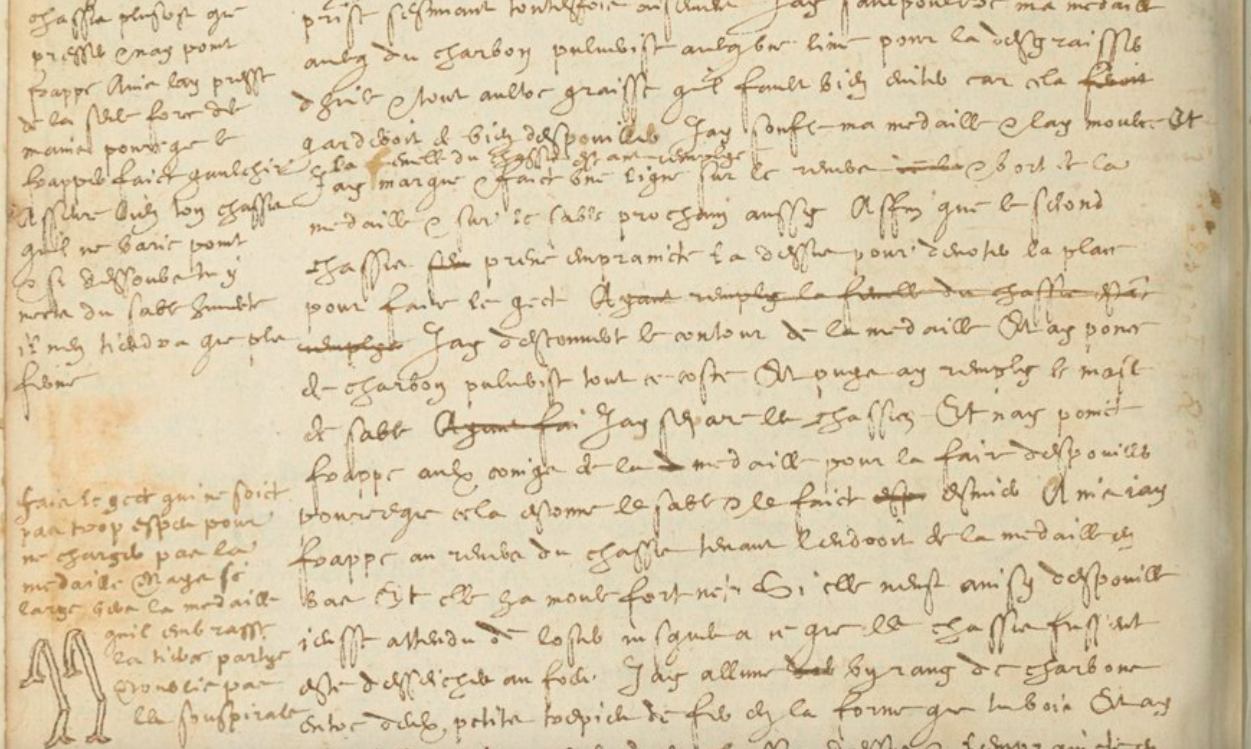The digital critical edition is openly accessible at https://edition640.makingandknowing.org.
Hi-Def Images of the Ms. (Gallica)
When citing the editon, please use:
The Making and Knowing Project, Pamela H. Smith, Naomi Rosenkranz, Tianna Helena Uchacz, Tillmann Taape, Clément Godbarge, Sophie Pitman, Jenny Boulboullé, Joel Klein, Donna Bilak, Marc Smith, and Terry Catapano, eds., Secrets of Craft and Nature in Renaissance France. A Digital Critical Edition and English Translation of BnF Ms. Fr. 640 (New York: The Making and Knowing Project, 2020), https://edition640.makingandknowing.org.
Please visit our edition citation page to learn more.
A Book of Secrets?
BnF Ms. Fr. 640 resembles most closely “books of secrets” that began circulating in the Middle Ages and then were printed in large numbers from the last decades of the sixteenth century. Lacking a clear title, the manuscript text was bound in the seventeenth century with the title of Choses Diverses, and then as Recueil de recettes et secrets concernant l’art du mouleur, de l’artificier et du peintre by the BnF. Although “books of secrets” sound esoteric, they are, in effect, books of techniques, which, while practical and useful, also hint at the tacit dimension and initiation process of much craft knowledge.
BnF Ms. Fr. 640 differs significantly, however, from other such collections of techniques in its apparent lack of formulaic recipes, its constant reference to the writer’s own experiences, its extensive observations of animal behavior, and its sketched illustrations of technical points. The margins of the instructions are filled with the practitioner’s comments on his experiments with different materials and procedures, an indication that the manuscript was most likely a set of working notes. The anonymous author-practitioner is a vocal and sometimes self-reflective witness to his culture, and his text offers insight into how natural materials and art objects were collected, appreciated, and circulated in a period of burgeoning production and consumption of material goods. BnF Ms. Fr. 640 provides a rare view into the experience and significance of experimenting with and improving artistic techniques, as well as into attitudes to natural materials and processes.
Click here to see a marginal annotation from the Ms.
The author practitioner wrote in a marginal note on fol. 118v next to a recipe for “Casting in Box Molds”:
“Note that I filled the box mold before pressing it, and did not hit it, but rather pressed it with the strength of my hands alone, because hitting it makes it go awry. Secure your box mold that it does not shift at all, & if you put some moistened sand under it, it will only hold in place more firmly.”
Recipe Books and How-To Manuals
Art historians, as well as historians of science and of material culture have recently become interested in the genre of early modern recipes, books of secrets, and how-to manuals because they shed light on a remarkable transition in European society, when previously illiterate craftspeople began writing down their working procedures. These technical books, printed in large numbers and through many editions between the 1490s and 1800, are now seen to have great significance in early modern Europe. Recent scholarship on recipes and technical writing has drawn attention, for example, to the importance of “makers’ knowledge,” and has illuminated the broader epistemological significance of art in early modern culture. Moreover, these technical manuals are now viewed as having fostered new attitudes to the creative process and to technical ability.
BnF Ms. Fr. 640 seems to be unique among such technical writings. Other such manuals lack the immediacy, self-reflexivity, and process-oriented character of Ms. Fr. 640. This unusual document thus gives a remarkable view into the sixteenth-century artist’s workshop, allowing scholars glimpses of the methodical experimentation undertaken in the production of art, the obviously laborious process of translating workshop procedures into words on paper, and the author-practitioner’s taken-for-granted stance that his art-making functioned as a tool for the investigation of nature.
The procedures in this craft text seem not to be meant to be reproduced solely through the act of reading, but rather to be an invitation to imitate and experiment. By taking up this invitation and reconstructing the techniques contained within it, the critical edition we are producing will make accessible an exceptionally intriguing and important source that will significantly enhance the corpus of early modern recipe collections, and also allow readers to understand and analyze the act of making art as the creation of knowledge.







